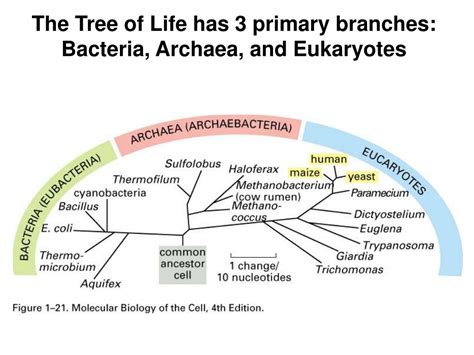The realm of microorganisms is vast and fascinating, with a multitude of life forms that have evolved over billions of years. Among these, three main categories stand out: Bacteria, Archaea, and Eukaryotes. Each of these groups represents a distinct branch on the tree of life, characterized by unique features, lifestyles, and evolutionary histories. Understanding these differences is crucial for grasping the diversity of life on Earth and how these microorganisms impact our daily lives, from health and disease to ecology and biotechnology.
Bacteria: The Pioneers of Life
Bacteria are perhaps the most familiar microorganisms to the general public. They are prokaryotic cells, meaning their genetic material (DNA) is not enclosed within a nucleus. This group includes some of the most ancient forms of life, with fossil records suggesting that bacteria have been present on Earth for at least 3.5 billion years. Bacteria are incredibly diverse, ranging from harmless gut flora to pathogens like Escherichia coli (E. coli) and Staphylococcus aureus. They play crucial roles in ecosystems, including decomposition, nitrogen fixation, and as primary producers in certain environments. Their ability to adapt to virtually any habitat on Earth, from the freezing cold to the extremely hot, underscores their remarkable resilience and versatility.
Key Characteristics of Bacteria:
- Lack a true nucleus and other membrane-bound organelles.
- Typically small, ranging from 0.5 to 5.0 micrometers in size.
- Have a cell wall that provides structural support.
- Can be autotrophic (producing their own food) or heterotrophic (relying on external food sources).
- Reproduce asexually through a process known as binary fission.
Archaea: The Ancient Ones
Archaea are also prokaryotic cells, similar to bacteria, but they represent a distinct domain of life. They are often found in extreme environments, such as hot springs, salt lakes, and even the guts of certain animals. Archiea are known for their unique metabolic processes, including methanogenesis (the production of methane) and the ability to thrive in environments with extreme temperatures, salinity, and acidity. Despite their extremophilic nature, Archaea also play critical roles in more mundane ecosystems, influencing the carbon cycle and serving as part of the microbial community in soils and oceans.
Key Characteristics of Archaea:
- Like bacteria, they lack a true nucleus and other membrane-bound organelles.
- Generally smaller than bacteria, but size can vary.
- May have different types of cell walls or membranes compared to bacteria.
- Many are autotrophic, using chemosynthesis to produce energy.
- Also reproduce asexually, often through binary fission.
Eukaryotes: The Complex Life Forms
Eukaryotes represent a significant departure from the prokaryotic world of bacteria and archaea. These organisms have cells with a true nucleus, where the genetic material is enclosed within a nuclear membrane, and other membrane-bound organelles that perform specific functions. This complex cellular structure allows for a high degree of specialization and organization within the cell. Eukaryotes encompass a wide range of life forms, from single-celled organisms like protozoa and algae to multicellular organisms such as plants, animals, fungi, and humans. The evolutionary advantage of eukaryotic cells lies in their ability to support complex life processes, including multicellularity, sexual reproduction, and sophisticated sensory and nervous systems.
Key Characteristics of Eukaryotes:
- Possess a true nucleus and other membrane-bound organelles.
- Generally larger than prokaryotic cells, with sizes ranging from a few micrometers to several meters in the case of multicellular organisms.
- Have complex cellular structures, including mitochondria for energy production and, in plants and algae, chloroplasts for photosynthesis.
- Reproduce both sexually and asexually, depending on the species.
- Can form complex multicellular organisms with specialized tissues and organs.
Conclusion
In conclusion, the distinctions between Bacteria, Archaea, and Eukaryotes underscore the incredible diversity of life on Earth. Each of these groups has unique characteristics, evolutionary paths, and contributions to ecosystems. Understanding these differences not only enriches our knowledge of biology and ecology but also informs fields such as medicine, agriculture, and environmental science. As we continue to explore and learn about these microorganisms, we uncover new avenues for biotechnology, drug development, and sustainability, highlighting the critical role that microbial life plays in our world.
FAQs
What are the main differences between prokaryotes and eukaryotes?
+The primary difference lies in the presence or absence of a true nucleus and membrane-bound organelles. Prokaryotes (bacteria and archaea) lack these features, while eukaryotes have a complex cellular structure with a nucleus and various organelles.
Why are extremophilic microorganisms important?
+Extremophilic microorganisms, such as certain archaea, are significant because they can survive in extreme conditions. This ability makes them valuable for studying adaptation mechanisms, enzymes with unique properties, and potential applications in biotechnology and environmental remediation.
How do eukaryotic cells support complex life processes?
+Eukaryotic cells support complex life through their advanced cellular structure, which includes a nucleus, mitochondria, chloroplasts (in plants and algae), and other organelles. These components enable processes like photosynthesis, respiration, and complex metabolic pathways, supporting the evolution of multicellular life forms with specialized functions and behaviors.



